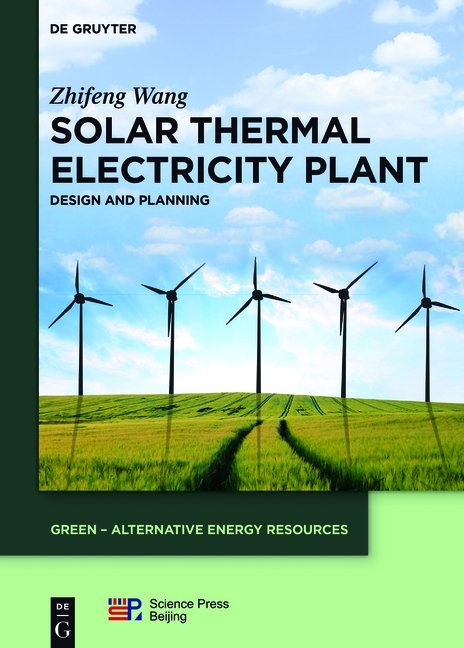
Solar Thermal Electricity Plant
De Gruyter (Verlag)
978-3-11-037834-4 (ISBN)
- Titel wird leider nicht erscheinen
- Artikel merken
Zhifeng Wang, Institute of Electrical Engineering, CAS, Beijing, China.
lt;br />1 General
1.1General principles of STE plant design
1.2 A STE plant
1.3 Pressure parameters of power generators
1.4 Heat transfer fluid used in solar receiver
1.5 Capacity plan and number of generators
1.6 Environmental impact control
1.7 Seismic and wind resistance Design of heat collection system
1.8 Design principles of a concentrator field
2 Outline
2.1 Basic concepts of a STE plant
2.1.1 Basic concepts of STE technology
2.1.2 Characteristics of STE technology
2.1.3 Comparison of STE and solar photovoltaic power generation
2.2 Main technological forms
2.2.1 Power tower system
2.2.2 Parabolic trough concentration solar thermal power
2.2.3 Dish/Stirling engine system
2.2.4 Linear Fresnel reflector system
2.3 Basic terminology
2.3.1 Optics
2.3.2 Thermodynamics
2.3.3 System
3 Solar resource and meteorological parameters
3.1 Nature of solar energy resources
3.1.1 Advantages of solar resource utilization
3.1.2 Disadvantages of solar resource utilization
3.2 Solar constant and the radiation spectrum
3.2.1 Expression of solar irradiance
3.2.2 Solar radiation spectrum
3.3 The impact of the atmosphere on solar radiation
3.3.1 Solar elevation angle
3.3.2 Air mass
3.3.3 Atmospheric transparency
3.3.4 Geographic latitude
3.3.5 Sunshine hours
3.3.6 Altitude
3.4 Calculation method of solar position
3.4.1 Sun Angle
3.4.2 Angle calculation of the tracking surface
3.5 Solar resource distribution of several typical areas in China
3.5.1 Solar resource in Beijing area
3.5.2 Solar resource in Lhasa area
3.5.3 Solar resource in Golmud area
3.5.4 Solar resource in Dunhuang area
3.5.5 Solar resource in Turpan region
3.5.6 Solar Resources in Guizhou Province
3.5.7 Solar Resources in Hainan island
3.5.8 Solar Resources in Harbin
3.6 Solar irradiance forecasting method
3.6.1 Estimation method of Direct Normal Irradiance (DNI)
3.6.2 Impacts of Changes in weather conditions on Direct Normal Irradiance
3.7 Direct Normal Irradiance distribution in China
3.7.1 Yearly mean daily Direct Normal Irradiance distribution
3.7.2 Factors Affecting DNI Spatial and temporal distribution
3.7.3 The basic characteristics of China's solar energy resources
3.7.4 China's solar energy resources zoning
3.7.5 Measurement of solar Direct Normal Irradiance
3.8 Special meteorological data required for site selection
3.8.1 Ambient temperature
3.8.2 Wind velocity
3.8.3 Precipitation
3.8.4 Severe Weather
3.9 Measurement instruments
3.9.1 Pyranometer
3.9.2 Pyrheliometer
3.9.3 Atmospheric transmittance meter
4 Overall design of a STE plant
4.1 Design point
4.1.1 Significance of the design point
4.1.2 Calculation example using the design point
4.2 Heliostat field efficiency analysis
4.2.1 Transient optical efficiency of a heliostat field
4.2.2 Concentrating power at the aperture of a receiver
4.2.3 Spot size on the aperture
4.2.4 Value of specular reflectance
4.2.5 Analysis of atmospheric transmittance
4.2.6 Heat gain calculation of some cavity receiver
4.3 Thermal performance of parabolic trough solar collectors
4.3.1 Heat loss coefficient of parabolic trough receiver
4.3.2 Status quo of thermal performance measurement of parabolic trough solar collectors
4.3.3 Thermal performance testing methods of parabolic trough solar collectors
4.5 Basic data needed for STE plant design
4.6 Main parameters and principles
4.7 Overall parameters description
4.8 Calculation of annual electricity generation
4.8.1 Calculation using the design point method
4.8.2 An example of annual generation calculation
4.8.3 Plant capacity optimization
4.8.4 Generation calculation method based on hourly simulation
4.8.5 Impact of geographical location on the efficiency calculation of parabolic trough solar collector with DNI used as the solar irradiance source
4.9 Thermal energy storage capacity
4.9.1 Principles of thermal storage volume identification
4.9.2 Principles of thermal storage power identification
4.10
| Erscheint lt. Verlag | 15.9.2050 |
|---|---|
| Reihe/Serie | GREEN – Alternative Energy Resources ; 4 |
| Mitarbeit |
Sonstige Mitarbeit: China Science Publishing & Media Ltd. |
| Zusatzinfo | 150 schw.-w. Abb., 150 schw.-w. Tab. |
| Verlagsort | Berlin |
| Sprache | englisch |
| Maße | 170 x 240 mm |
| Themenwelt | Technik ► Elektrotechnik / Energietechnik |
| Schlagworte | Energy Harvesting and Conversion • Engineering • Industrial Chemistry • renewable energy • Renewable energy, Engineering, Thermophysics • Solarkraftwerk • Thermophysics |
| ISBN-10 | 3-11-037834-5 / 3110378345 |
| ISBN-13 | 978-3-11-037834-4 / 9783110378344 |
| Zustand | Neuware |
| Haben Sie eine Frage zum Produkt? |
aus dem Bereich


